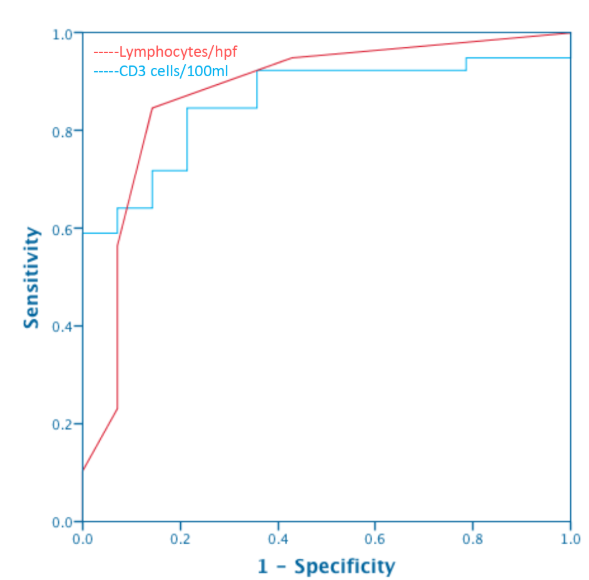Session Information
Session Type: Poster Session (Monday)
Session Time: 9:00AM-11:00AM
Background/Purpose: Multiple urinary biomarkers have been described for lupus nephritis, however none has reached the clinic due to either complex methodology or low discriminatory power. Recently, urinary CD4 and CD8 T cells have shown high specificity for active lupus nephritis (LN). Thus we studied whether urinary lymphocyte count by simple staining of sediment or T cell count by flowcytometry can serve as a simple and cheap biomarker.
Methods: Patients with active LN (ALN) defined as renal SLEDAI (rSLEDAI) >4, active lupus without nephritis (ANR) defined as SLEDAI >4, inactive nephritis (IN) defined as rSLEDAI ≤4 and SLEDAI < 4, and age matched healthy controls(HC)were included. Renal biopsy was done if not contraindicated. Lymphocytes in the urine were stained using Kovak stain and reported as number of cells/high power field. CD3 T cells were counted by FACS using anti-CD3 antibody and DAPI for live gate. Immunohistochemistry was done on formalin fixed paraffin blocks of renal biopsy for CD3 and the distribution and number of cells was counted. Statistical analysis was done using SPSSv23.0
Results: Among 74 patients, 44 had ALN (40 females, mean age 30 years and mean SLEDAI:12.9±6.5), 10 had ANR disease (9 females, mean age: 27 years, mean SLEDAI:8.3±3.74)and 20 patients had IN (19 females, mean age: 33 years, mean SLEDAI:0.35±0.74). 10 healthy controls (all females, mean age:26 years) The median(IQR)Lymphocyte count in the urine was 4(7) in ALN as compared to ANR [2(3.5),p=0.1], IN (0, p< 0.001) and HC(0,p< 0.001). The median CD3 count by FACS was 2793(8982) in ALN as compared to ANR [209(539.2), p=0.001],IN [86(303),p< 0.001] and HC [115(195),p< 0.001).There was moderate correlation between lymphocyturia and urinary CD3 count (r=0.59, p< 0.001).
Lymphocyturia had moderate correlation with SLEDAI (r=0.59, p< 0.001), rSLEDAI(r=0.58, p< 0.001). Similarly, urinary CD3 cell count had moderate correlation with SLEDAI (r=0.47,p< 0.001), rSLEDAI (r=0.54, p< 0.001).The ROC curve for lymphocyturia to differentiate ALN from IN (AUC: 0.87) and for CD3 (AUC: 0.874)[Fig 1].
In 15 patients of ALN on follow up, there was a excellent correlation between change in SLEDAI and change in lymphocyte count (r=0.845,p< 0.001).In 31 patients with renal biopsy, there was a moderate correlation between the CD3 cells by IHC in tubulointerstitial compartment and urinary CD3 cells(r=0.55,p=0.001) however there was no relation with glomerular CD3 count
Conclusion: Lymphocyturia measured by simple staining of urinary sediment can be a cheap and effective marker of active LN and can be used to follow up patients with active nephritis in resource poor countries.
To cite this abstract in AMA style:
Pattanaik S, Singh A, Venkataraman S, Misra R, Agrawal V, Aggarwal A. Lymphocyturia Is a Good and Cheap Biomarker for Active Lupus Nephritis and Is Sensitive to Change [abstract]. Arthritis Rheumatol. 2019; 71 (suppl 10). https://acrabstracts.org/abstract/lymphocyturia-is-a-good-and-cheap-biomarker-for-active-lupus-nephritis-and-is-sensitive-to-change/. Accessed .« Back to 2019 ACR/ARP Annual Meeting
ACR Meeting Abstracts - https://acrabstracts.org/abstract/lymphocyturia-is-a-good-and-cheap-biomarker-for-active-lupus-nephritis-and-is-sensitive-to-change/

